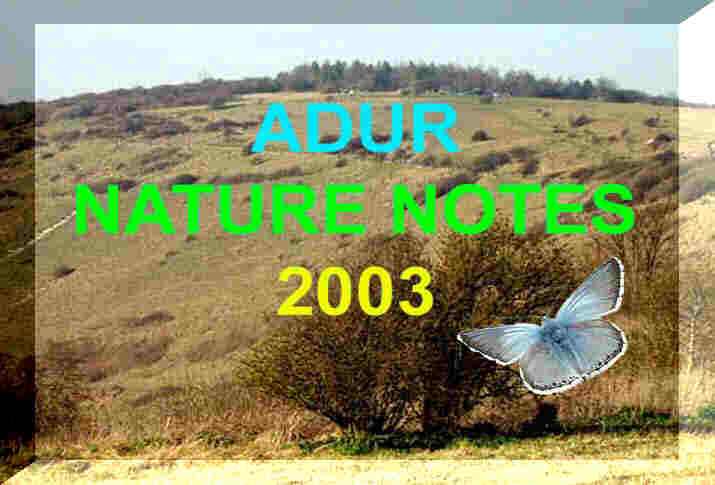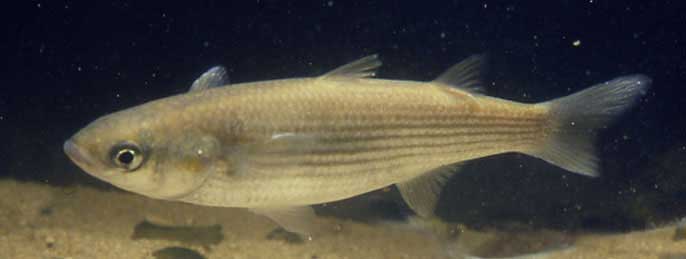 |
| Adur Flood Plain |
| Chalk Downs |
| Coastal Fringe |
| Intertidal (Seashore) |
| River Adur Estuary |
| River Adur |
| Sea (off Sussex) |
| Town & Gardens |
| Widewater Lagoon |
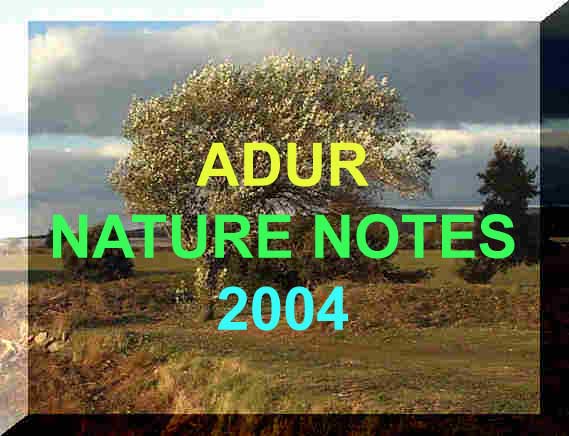
|
|
|
|
(ADUR VALLEY & DOWNS) |
|
|
The River Adur Estuary is wide expanse of mud-flats at low water, with the river flow cutting a narrow path, and a tidal inlet at high tide.
High spring tides occur around midday.
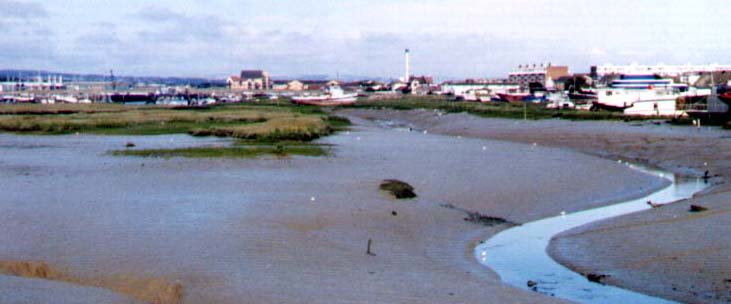
- The
mud flats are a roosting site for gulls and waders, especially in the colder
months.
The mud flats (TQ 208 056) including the RSPB Reserve has been notified from 1987 as a Site of Special Scientific Interest (SSSI) under Section 29 of the Wildlife & Countryside Act 1981.
This page is for the estuary as it runs through Shoreham town. The harbour entrance and Silver Sands reports are more likely to be on the Kingston Beach page.
Common Birds of the Estuary
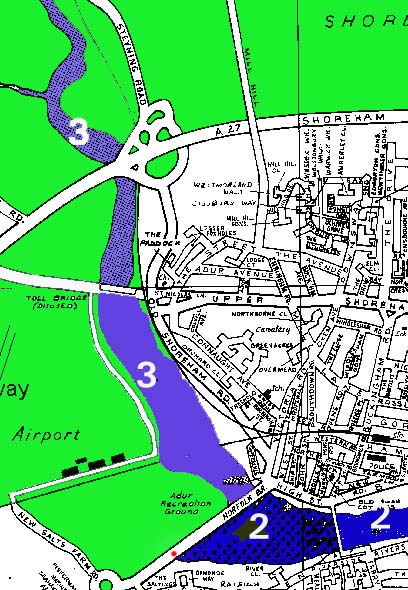
Black-headed
Gull
Great
Black-backed Gull
Dunlin
Redshank
Mute
Swan
Cormorant
Starling
Crow
Lapwing
Herring
Gull
Common Gull
Turnstone
Little
Egret
Ringed
Plover
Redshank
Less Common Birds
Grey
Heron
Dabchick
(Little Grebe)
Oystercatcher
Common
Tern
Coot
Mallard
Teal
Kingfisher
Grey
Plover
Sandwich
Tern
Red-breasted
Merganser
Brent Goose
Rare Birds
Mediterranean Gull
Wildlife ReportsLink to the Reports 2004 et. seq.
18 November 2003
There was an unringed Little Egret feeding on the long neap tide, a statuesque Grey Heron and a Cormorant on a pole, with a Redshank, Great Black-backed Gulls, and a handful of Mallard all within the frame of a wide-angle lens next to the Toll Bridge if I deigned to take the photograph. This is not exceptional and should be regarded as what to expect in late autumn. Usually, at least one of these birds would be missing though.14 November 2003
Three Oystercatchers were feeding (searching for small molluscs or worms) on the water's edge of the mud flats near the houseboats. These birds were by the inlet leading to the flood overflow (the Flood Arch) by Adur Recreation Ground. The main mud bank (opposite Shoreham town) was full of scores of Great Black-backed Gulls, hundreds of Lapwings, Redshanks, Dunlins and most of the usual estuarine birds. Near the Toll Bridge, where holding the binoculars steady in the Force 5 Strong Breeze was tricky, there was about a dozen Grey Plovers amongst all the other waders and gulls.12 November 2003
Just a half dozen Grey Plovers at a half spring tide, hardly worth a mention with the noisy and alert Redshanks and small flocks of Dunlins and Ringed Plovers, with scores of Black-headed Gulls, a handful of Herring Gulls, a few Crows and Cormorants, and there were as many regular species of birds missing on the mud south of the as there were present.29 October 2003
The number of Cormorants flying over the Adur levels, with a few in the River Adur, between Old Shoreham and Botolphs exceeded one hundred, in just over an hour, a number not seen before by myself. Normally I would expect to see under thirty.
Cormorant Roost (Link)20 October 2003
Small patches of what is probably Townsend's Cord Grass, Spartina townsendii, were found south-east of the Toll Bridge.
Cord Grass ImagesAlthough not quite so dramatic as the Glasswort on Widewater, the Sea Blite on the estuarine margins had turned a dramatic red.
Adur Mudflats19 October 2003
The neap tide variation between 2.36 metres (low at 12.04 pm) and the high tide of 4.4 metres (6:14 pm in darkness) is one of the smallest possible. (The equinoctial spring tide variation could be up to 7 metres).
BMLSS Tides17 October 2003
The neap tides show the smallest rise and fall possible with only a three metre variation and this is even less in the next few days. Maybe, this would explain why the Turnstones were feeding on the muddy bits just north of the Railway Viaduct?15 October 2003
The River Adur estuary between the Railway Viaduct and the Toll Bridge is not entirely mud at low tide and there is an area of loose rocks on a harder bedrock. One bird that was interesting had bright red legs seen in the weak sunshine and was quite energetic in its quest for food: there were about a dozen of these Turnstones and about the same number of the better camouflaged Ringed Plovers. The following birds were present and not listed at dusk a couple of days ago: Great Black-backed Gulls, Herring Gulls and a Crow. A single Swallow flew over the river.13 October 2003
The Pied Wagtails, Motacilla alba, seem to have foregone their attempt to roost on Courts Furniture Store and just before dusk scores of these small birds could be found over the Ricardo engineering complex north-west of the Toll Bridge at Old Shoreham.
On the mudflats south of the Toll Bridge, the usual typical selection of seabirds had settled: hundreds of Black-headed Gulls, over a hundred Lapwings, over a dozen each of Redshanks, Grey Plovers and Dunlins. There were at least two Little Egrets and two Cormorants, a statuesque Grey Heron, and a handful of Mute Swans with full-sized cygnets.11 October 2003
The SHOREHAM FISH FESTIVAL on Coronation Green, Shoreham-by-Sea, West Sussex, was attended by 4,000 people if the sunshine as the high six metre spring tide filled the river just before 1:00 pm. The British Marine Life Study Society held an aquarium display which was well received by the younger age group.16 September 2003
The green of the Glasswort, Salicornia, on the River Adur was in contrast to the rich red-purple hues of the mostly submerged (this year) Glasswort on Widewater.On close examination, the larger river Sea Blite seemed to have a red line up their stems.
Mudflats Special Page12 September 2003
As the tide receded underneath the Railway Viaduct leaving the shallow pools between the exposed mussel beds, a Little Egret was dipping its beak into the water searching for food. The pools are known (from previous observation) to hold scores of small (smaller than 3-spined Sticklebacks) first year Rock Gobies in September, as well as Common Gobies.8 September 2003
In a warm 23° C gentle breeze from the south-east it felt like a summer afternoon, but I could tell it was autumn because of the hundred plus Lapwings on the mud, near the water's edge, south of the Old Shoreham Toll Bridge on the ebbing neap tide. Lapwings spend the colder months in and around the lower estuary before moving inland to breed in the spring.
North of the A27 flyover just south of the first stile, a Grey Heron stalked small fish that were producing an occasional ripple on the still river.
31 August 2003
Young Terns dived into the Adur after small fish at the highest point of equinoctial spring tide at Silver Sands, Shoreham Beach.25 August 2003
As the Orientals cooked cockles in their shells over a barbecue by the Railway Viaduct on the low neap tide of August Bank Holiday Monday, there must be fish in the river because nearly a dozen Cormorants were either fanning their wings on the mud banks or resting and diving under the water. A Little Egret was preening itself on a sunken boat mid-stream. At least 20 Ringed Plovers were running around on the mud.12 August 2003
A count of eleven Little Egrets on the River Adur by Shoreham Airport between 8:20 pm and 8:50 pm must be a new record. One or two is usual, four exceptional, but only seven of the birds were in view at the same time.
31 July 2003
There were 67 Mute Swans and one Australian Black Swan on the river at low tide south of the Toll Bridge and visible from the riverbank by Adur Metal Works. Four of the Mute Swans could be seen by Adur Recreation Ground under the Railway Viaduct.26 June 2003
The Australian Black Swan remains amongst the Mute Swans between the Railway Viaduct and the Toll Bridge.21 June 2003
21 Mute Swans and one newsworthy Australian Black Swan were on the River Adur by the Toll Bridge, approaching the high spring tide.17 June 2003
A single Oystercatcher was probing for worms or molluscs at low tide by the houseboats in Shoreham. This is unusual during summer.14 June 2003
45 Mute Swans were counted on the still tidal part of the River Adur at Upper Beeding by the disused Cement Works.31 May 2003
Shoreham bathed in a heatwave up to 24° C for the opening of the Adur Festival and Adur World Oceans Day 2003 on Coronation Green, Shoreham-by-Sea. About 3000 people attended the event that was steady and busy throughout.Adur World Oceans Day 2003
10:00 am - 4:00 pmPopular Information File on Adur World Oceans Day 2003
Acrobat Information File on Adur World Oceans Day 200325 May 2003
A quick check of the gulls on the Adur opposite the airfield this evening produced a first summer Glaucous Gull loafing with about 20 other large gulls. It was present from at least 6:00 pm, but flew off south at 6:33 pm. There were about 200 large gulls roosting near the houseboats later. There seems to have been an increase of large gulls on Widewater in the last few days. A passing fishing boat became "engulfed" in gulls until it was barely visible! (The local boats are currently fishing for cuttlefish.)
Image (Link to)Report by Christian Melgar via the Sussex Birds Yahoo GroupSussex Birder Web Site21 May 2003
A Glaucous Gull (1st or 2nd summer), Larus hyperboreas, is seen again at Widewater, Lancing at 10.15 am and again at 11.30 am, when it flew towards the River Adur. The Glaucous Gull is an Arctic species and a rare visitor to southern England. It is a large species only exceeded in size by the Great Black-backed Gull, one of which has been resident at Widewater since the beginning of 2003.
The Herring Gulls are posing me identification problems because of their variation in colours and similarity to Lesser Black-backed Gulls.The above photograph demonstrates the problems in adults. The bird on the right has a much darker, almost black, compared to the gull on the left. There may be two distinct races of Herring Gulls found in southern England. The juvenile birds with their mottled brown coloration present even greater difficulties: the bird on the far left in the photograph appears to have a black tip to its beak.
6 May 2003
Afternoon
As the River Adur turns on the approach from the sea north of the A27 Flyover, the unmistakable downturned long beaks identified either a couple of Whimbrels or a pair of Curlews that seemed to be resting or feeding in the lee of the west bank at mid-tide. This was the first time I had seen these waders on the river estuary and they came as a bit of a surprise. Alas I did not have experience to differentiate the two species. It seemed that the shorter more downturned beak was nearer the Whimbrel, but I failed to observe the differences in the head markings between the two species of wading birds with downturned beaks. (However, the beak of the male Curlew is shorter than that of the female. Whimbrels have been identified from the Arun valley this month, but both species could be passage migrants.)14 March 2003
On the mud flats south of Old Shoreham Toll Bridge the low spring tide had receded a low way so in the fading light it was difficult to identify some of the wading birds through my low powered (10 x 25) binoculars. There were fifteen medium-sized wading birds in the shallows on the water's edge. At least three were Redshanks as the red colour of their legs discerned as they trotted quickly over the mud itself, but the other waders appeared to be a different species, with black legs and bill and a dark head (possibly Godwits?). They were very active wading in water up to their knees, probing very deeply into the mud. They were probably all Redshanks, but it is unusual to see them on Adur in small flocks - they are usual single, with perhaps a couple more in close proximity. Much easier to recognise, were a pair of Shelducks, just a solitary Dunlin, three Mute Swans, a couple of feeding Little Egrets and a couple of Great Black-backed Gulls.1 March 2003
Five Purple Sandpipers as well as about five Turnstones were on the central wooden pier near the Old Fort, Shoreham Beach. (TQ 234 045)Report by Richard Fairbank
26 February 2003
A couple of Shelducks waddled in the mud just south of the Toll Bridge.18 February 2003
Two Shelducks with bright red beaks followed by a Ruddy Shelduck ventured close in to the shore on a high spring tide just south of the Old Shoreham Toll Bridge and swam around poking their heads under water, presumably to tug at the vegetation to eat.27 January 2003
Midday: The sun came out today. It was a low neap tide at 1.6 metres on the Adur between the Toll Bridge and the Railway Viaduct with over a thousand Black-headed Gulls, nearly a thousand Lapwings, over a hundred Dunlins, an uncounted number of Ringed Plovers, a handful of Great Black-backed Gulls, at least three Cormorants fanning their wings on the mud banks, the inevitable Mute Swans, an occasional feeding Redshank, and just a solitary actively feeding Bar-tailed Godwit, in the shallow water, dipping its long beak repeatedly in the mud, the raised slightly upcurved beak slightly agape. This bird selection is usual perhaps even slightly disappointing for the first two months of the year. Crows were amongst the mud and rocks and even House Sparrows were feeding amongst the Sea Purslane.
Watching note: from the bank (submerged on a spring tide) the viewing through basic (medium quality) 12 x 40 binoculars was only just about sufficient and it was still a bit of a struggle to discern shapes, and colours (legs of birds) in the winter light was difficult.
3:30 pm: The river still looked very low although the tide measurement at the harbour entrance was now 3 metres. A Grey Heron had arrived and stood like a stature at the end of the sand spit with 30 newly arrived Great Black-backed Gulls, plus some Herring Gulls.. The Godwit and most of the Lapwings had departed, but amongst the hundred plus Dunlins, exactly a dozen Grey Plovers stood out looking like dumpy oversized Dunlins with short beaks. They just stood there in their black legs and to the inexperienced could be mistaken for immature gulls. There were more Redshanks to be seen on the mud nearer the shore, where Pied Wagtails were present fluttering over the dried out mud as expected.
Through my 9 x 35 binoculars, the view was just as good, or bad as a magnified image (telescope) would have been much better, but the colours were slightly clearer, but with the sun low in the sky conditions were very tricky.
North of the Toll Bridge, there was a single Oystercatcher amongst the 100+ Lapwings.26 January 2003
A Bar-tailed Godwit was spotted just south of the Old Shoreham Toll Bridge, the first time I have seen this wader here. This confirmed my earlier report. Also a very lonely-looking Brent Goose was around!Report by Chris Barfield via Sussex Ornithological Society News
23 January 2003
At high tide, there was just a small patch of mud covered in greenery (Glasswort and algae) south of the Toll Bridge (TQ 207 058), occupied by about 150 Lapwings and one other mottled grey and white wader with a long nearly straight beak and a glimpse of black tail feathers. The Lapwings were disturbed but this bird remained unperturbed. Occasionally, it tucked its beak into his chest so the beak was invisible. I watched it for over ten minutes, long enough for a plump Ringed Plover to arrive. Still the wader remained stationary with a few struts, but it did not feed. It was definitely a Godwit, and I think it was a Bar-tailed Godwit, Limosa lapponica, and this was the first time I have noticed this easily overlooked wading bird on the estuary. Black-tailed Godwits have also been recorded on the Adur.16 January 2003
A pair of Shelducks were on the Adur between the Railway Viaduct and the Toll Bridge (TQ 2105 0530).Report by Jan Hamblett (Lancing Nature)
9 January 2003
The air temperature only crept above freezing at midday, where 30 Mallards on the mud flats near the Footbridge, buried their heads into their feathers.
On the small area of exposed mudflats (TQ 210 053) just north of the Railway Viaduct spanning the Adur at Shoreham, a couple of Oystercatchers were probing continually in the soft mud for food. The usual Lapwings were present, and I heard the squawky alarm call of the Redshank twice within 30 metres of riverbank, but it was the hundreds of Dunlins all over the mud, not just at the water's edge, that were most noticeable. They were more numerous near the Toll Bridge.3 January 2003
Amongst the scant remaining vegetation at a high spring tide, at least three pipits perched and flew around just above the water surface south-west of the Footbridge over the Adur (TQ 216 047). These were not the plump Meadow Pipits of the local fields but a different bird altogether, thin and straggly with a much paler breasts with plenty of white and a more marked face with a dark top. The white, or was it grey, tail feathers were not so bright either. So this bird was either a Rock Pipit (Scandinavian Race) or a Water Pipit, Anthus spinoletta. They were not easily perturbed, but they all flew off over the estuary before I could get my camera out. It seems from research and consultation that the identity is most likely to be a Water Pipit, which is not what I thought of at first. (The full subspecies name of the Rock Pipit (Scandinavian Race) is Anthus petrosus littoralis.) These pipits can be a bit tricky to identify.
Last Meadow Pipit Report
Pipit on Lancing Beach
Rock Pipit Report
Trouble with Pipits Identification
Anthus petrosus littoralis (Sussex records)
Rock Pipits Observation Page (BMLSS)
Rock Pipits (Birdguides)
Water Pipits

27 December 2002
Straight as an arrow, the Kingfisher flew the the length of the stream by Adur Metal Works, just over over a metre above the surface of the contaminated water, the turquoise showing for the complete length of the sudden flight under the doctored branches of surviving Monterey Cypresses (TQ 210 053).
The Little Egret on the adjacent mud flats looked to be very slender and to have a much finer beak than normal. Maybe, it was a juvenile bird probing in the shallows at half tide.20 December 2002
Midday
Cycling east over the Toll Bridge I turned south at the downslink junction. At this point a pedestrian 50 metres in front of me flushed out a bird which flew up the path towards me in a low undulating fashion. Having time to focus my eyes as it flew past following the path northwards I recognised it to be a Kingfisher. The vivid turquoise shine on it's back as it travelled north was a glimmer of brightness on an otherwise overcast day. Continuing southward along the track nest to the river I spotted solitary diving duck. Further down in the shallows a Little Egret was fishing, it allowed me to come quite close to it but to my chagrin I did not have a camera with me.Report by Jan Hamblett via the the Adur Valley EForumThe Kingfisher was also spotted around midday by Helen Swyer, who followed it as it came to rest on the remains of the rotting boat on the east side of the river.Late Morning
With the Adur on a high spring tide as still as a mill pond, a Red-breasted Merganser dived beneath the milky waters just south of the Toll Bridge.
I noted that theMeadow Pipits on the cycle path and airport showed their tail underwing as a very distinctive bright white in contrast to their rich chocolate brown speckled breasts. These birds were streaked with the orange very distinct against the dark brown, larger than expected, and more thrush-like in appearance.
NB: So different (thrush-like) were these pipits from the local pipits in the fields, e.g. on New Monk's Farm, and so pronounced were the white outer tail weathers in contrast to the dark other feathers, that I do not think that these are local pipits but migrant birds moving south. My favourite choice is a Meadow Pipit that has recently moulted. Meadow Pipits are reported to undergo a partial moult in the first three months of the year. Some books make a distinction based on colour and the darkest birds are known as whistleri and are meant to be found in Ireland and western Scotland. These may be known as thereas in earlier books and these are the darkest of the Meadow Pipits. The thereas plumage distinction is now thought not to be distinct enough to warrant separation.
Ref: British Larks, Pipits and Wagtails (by Eric Simms NN 1992).As it was high tide the hundreds of Lapwings were on the airport grass.
30 November 2002
The albino/leucistic (white-winged) Magpie is seen again, this time I saw it very clearly in the small trees bordering the Adur estuary between the Norfolk Bridge and the houseboats (TQ 210 047), opposite (east side of) Adur Recreation Ground. The bird did not have the sleek clean appearance of a young bird.
Previous Report26 November 2002
On the small area of exposed mudflats (TQ 2105 0530) just north of the Railway Viaduct spanning the Adur at Shoreham, about 250 Lapwing roosted with three more energetic Grey Plover probing the mud, as the light faded and the tide began to fall.3 November 2002
The mudflats north of the Toll Bridge are dotted with Lapwings, poised with heads into the breeze (hundreds at this time of the year and throughout winter at low tide). Katherine Hamblett (8) wondered what might be under the rocks in the soft wet silt, it soon became clear that almost every rock has at least one small Shore Crab hiding beneath it.A Crow feeds on a small crab on the Adur riverbank
Lifting items of driftwood and other flotsam above the tideline in the hope of discovering Slow Worms, yielded nothing more than hundreds of spring-loaded Sandhoppers which scatter and vanish as the security of their hideout is breached.
11 October 2002
There were 30+ Redshanks on the estuary by the railway viaduct and hundreds of Lapwings.3 October 2002
A large jellyfish at least one metre in diameter was spotted in the River Adur underneath the footbridge at 10:00 am moving seawards, swimming actively with the ebbing neap tide. It had a milky white bell with a salmon-pink petticoat and frilly white tentacles. This is probably the Barrel Jellyfish, Rhizostoma octopus.Report by Hayley Packer
19 September 2002
A squadron of 16 Cormorants, immediately followed by another group of 17 Cormorants, followed less than a minute later by a single straggler, flew up the River Adur over the Toll Bridge. A few minutes later a further 10 Cormorants flew together in the same direction.10 September 2002
A Kingfisher flew straight as an arrow from the amongst the Sea Purslane at half tide towards the east bank of the Adur to the south of the Toll Bridge. It was too far away to see its bright colours.5 September 2002
At low tide by the Toll Bridge a bright orange/yellow-legged juvenile Redshank probed eagerly for food, so eagerly it did not give out its alarm call and fly rapidly away1 September 2002
A Little Egret was feeding on the mud flats near the footbridge.Report by Budge.
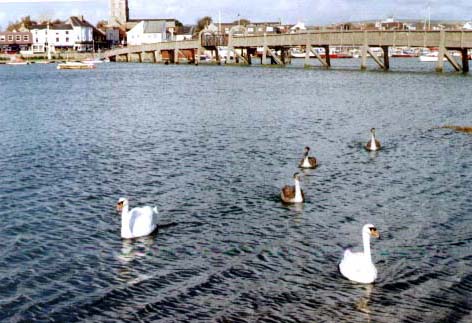
Mute Swans and cygnets at the south end of the footbridge
Mid-Late c. 21 August
A pair of Bottle-nosed Dolphins were seen by an angler and his wife porpoising on a medium tide in the entrance to Shoreham Harbour (outer Adur estuary).Discussion with a Lancing angler on 7 October 2002
28 April 2002
Common Terns, with their distinctive forked tails, were swept inshore by the unseasonal gales, and seen buffeted about over the River Adur estuary, opposite the houseboats in the centre of Shoreham town.Report by Bob WhitneyBMLSS birds (with a photograph)
Beaufort Scale (sea)15 March 2002
The Lapwings now all seem to have dispersed to search out their breeding territories, as there were none on the Adur at low tide. Three wheeling flocks of Dunlins each numbered over 30 birds and there were dozens of these small plump birds feeding on the mud and waterline, and the handful of Redshanks were too busy feeding to sound their alarm call.A solitary Rock Pipit was seen amongst the Sea Purslane. The bird was identified as a brown bird with greyish bordered tail feathers visible as it flew away. This was the first one I have identified locally, although they may have been spotted as Meadow Pipits before.
Kent Ornithological Society Rock Pipits Discussion11 March 2002
Eight Turnstones fed on the waterline on the low tide mussel beds underneath the Railway Viaduct on the River Adur. They were well camouflaged but their red legs could be discerned. This time when one of them preened its belly it was clearly white. Two further Turnstones flew over the viaduct and back again and then all eight of these wading birds flew off a short distance in formation, showing off their piebald patterns, and making their distinctive call.
Lapwings were absent, but the Little Egret was stalking the shallows on the opposite west side of the river by Adur Recreation Ground for a change.5 March 2002
Redshanks (x 8+) were noticeable amongst the energetic Dunlins (x 50+) and Grey Plovers with all of the common gulls on the mud north of the railway viaduct on the Adur estuary. Lapwings (known as Plovers by some walkers) were not seen.4 March 2002
The Adur by the railway viaduct was as still as a mill pond and as the light faded there was still plenty of water in the river and the strip of mudflats supported just a dozen Dunlins which were constantly feeding and four Grey Plovers, the larger dumpier wading bird that did not seem to be doing anything.12 February 2002
A flock of 25 Turnstones (confirmed) wheeled in by the Adur Railway Viaduct just like a flock of Dunlins. These birds were much stockier than the solitary Redshank, which was elegantly feeding within a few metres of a solitary one of these waders. Some of them waded in the pools near the mussel beds with their legs submerged, but they were not adverse to feeding on the mud flats.
These waders in their dull winter plumage were about the same size as a couple of Grey Plovers foraging along the water line at mid-tide.
- "A wader slightly smaller than a Lapwing, squatter and fatter than a Redshank, speckled a bit like a Thrush, bright red legs like an adult Redshank, shortish dark beak, jerky feeding, quite inclined to submerge its legs, in a small flock of 25 wheeling like a Dunlin flock, much larger than a Ringed Plover, but smaller than an Oystercatcher." -
A few Wrens arrowed between the scrub bushes by the disused railway route to the south-east of Old Shoreham Toll Bridge.
Seven Cormorants, six on the mud and one in the water, were opposite Coronation Green, Shoreham. There may be Eels or other fish in the River Adur to account for this number. Cormorants are frequently to be seen here, but usually in one or twos.
Adur Estuary Page10 February 2002
The wader feeding jerkily over the edge of mud and water near the railway viaduct with bright red legs (and smaller than a Lapwing) must surely be a Redshank, (but originally misidentified as a Turnstone). It was originally disturbed by the helicopter from a mud and rocks area, when it called twice as it flew about 30 metres to the water's edge. The other wader was probably a Grey Plover. On this murky day colours were a bit subdued.
14 January 2002
On the Adur mudflats, thousands of Lapwings exceeded any numbers I had noted before and they were on all the exposed mud on both sides of the river, with the greatest numbers near the Toll Bridge.
A few Grey Plovers searched for invertebrates on the mud. These waders were silent.10 January 2002
The River Adur estuary between the Norfolk bridge and the A27 Flyover sported a particular large number of sea birds as the low spring tide receded exposing the mud flats north of the Railway Viaduct and the mussel beds and gravel to the south. Nothing special although the large stumpy wader known as the Grey Plover made sudden darts to capture its food. In order of prevalence the bird selection with over a hundred birds included Lapwings, Black-headed Gulls, Dunlins and Black-backed Gulls. There were significant numbers of Redshanks, Oystercatchers, Herring Gulls, Common Gulls, and a few Mute Swans. A large Little Egret fished in a pool by the Railway Viaduct, and a Ringed Plover could be picked out from the gravel. On the vegetated mudflats by the houseboats, seven Grey Herons stood statuesquely. Crows foraged around the smaller boats by the Norfolk bridge and on the towpath adjacent to the airport. The absence of Cormorants was not an omission. There were none to be seen.
4 January 2002
A solitary diving bird on the River Adur, just north of the railway viaduct, on a flood spring tide on a murky afternoon was not familiar to me. This black bird with a white breast turned out to be my first choice of a Razorbill. The mystery is why this bird was on its own and not out at sea with the large flocks. The bird was probably injured.4 December 2001
Like an arrow a Grey Heron squawked continuously as it flew upriver over the footbridge crossing the Adur between Coronation Green and Shoreham beach. The Heron's bulk was smaller than the accompanying juvenile Herring Gulls, but when approached the roosting area for 40 Greater Black-backed Gulls, hundreds of Black-headed Gulls, a small flock of 40 Lapwings, its appearance caused hundreds of birds to take to the air. Rafts of Mallards numbered over 45 in one group, a larger number than normally seen on the River Adur estuary.
29 November 2001
A Full Moon is at 8:51 GMT, the second Full Moon in the month is known as a Blue Moon.
28 September 2001
In contrast to the previous week, the half tide was on the neaps, and the firmer mud banks near the Railway Viaduct were inhabited by nearly a hundred gulls. Almost all of these were Great Black-backed Gulls (70+) with a couple of Crows on an active scrounge, one Cormorant diving under and one fanning its wings on the bank, showing off its dirty-looking white belly, It was joined by the diving bird and both of them fanned their wings. A few Black-headed Gulls were resting on the slow flowing river. There was a small flock (25+) of Dunlins wheeling around as usual. Mute Swans are resident throughout the year on the part of the River Adur spanned by the five bridges in Shoreham.21 September 2001
I went for an extended look in the early evening at half-tide (springs) over the River Adur estuary between the Railway Viaduct and the Old Toll Bridge, which is the best viewing area. This was just in case the reported Osprey did turn up. I did not expect it to but I thought I would use the opportunity to have a good look around. The sentinel Redshanks quickly sounded an alarm call. The Mute Swans (20+) were the largest but the most spectacular birds present were a pair of Grey Herons that loomed large in the binoculars. The number of birds was not particularly large but the variety was better than a town garden after I adjusted by eyes to the mudflats and the rather sombre colours on a clear day with sun low in the sky after 6 o'clock. Gulls and waders predominated.
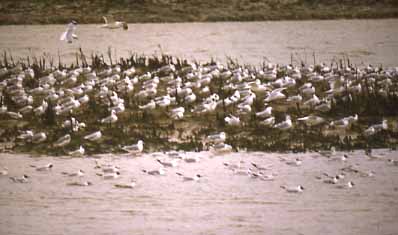
Almost all the hundreds of gulls were Black-headed Gulls, (200+) all with distinctive red legs, with an occasional Herring Gull and just a solitary Great Black-backed Gull on a pole. The Redshanks numbered about 20, and the largest flocks wheeling around were the probing Dunlins (50+). Some still had their black belly of their summer plumage. I have always noticed that the estuarine Ringed Plovers (35+) seem to look plumper than the ones on the shingle of Shoreham Beach. The larger Lapwings (25+) had not yet arrived in their normal large flocks. On the green Sea Purslane vegetation a pair of Crows were intent on searching for food.
In the river north of the Toll Bridge, the surface was rippled by shoals of young Sand Smelt, which scattered in many directions and there was a pronounced arrow-like disruption of the water surface, which probably indicated predation by a large fish, most likely to be from shoals of second year Bass.
19 September 2001
The Tide Chart forecasted a7 metre tide at Shoreham, which is about 0.5 metre higher than the highest tides forecasted for the 1970s. The River Adur lapped at the sea walls but there was no likelihood of a breach. The tide rose to within about 0.5 metre of the highest I have observed in February 1983.
A Little Egret was feeding in the shallows which were much nearer the bank than usual and flew low over the river to the airfield towpath on the opposite side of the river.
Link to Egrets at Thorney Island (1999)17 September 2001
The distinctive red legs of a returning Redshank stood out clearly in the fading light at the low spring tide on the mud bank of the River Adur underneath from the Footbridge crossing the river at Coronation Green, Shoreham.29 August 2001
The Grey Herons had left the meadows to feed at the low tide neaps on the River Adur north of the fly-over. Under the Railway Viaduct, tiny Common Goby fry, Pomatoschistus sp., were present in their thousands amongst the small clumps of Irish Moss, (a seaweed) Chondrus crispus. These fish would be too small (20 mm) and quick to excite the interest of even the Black-headed Gulls.15 August 2001
On the low River Adur neap tides between Ropetackle and the Toll Bridge at Old Shoreham, three Little Egrets (pic) stalked the shallows feeding in the shallow pools. One of the egrets seemed much larger than the other two through the binoculars. In what remained of the mainstream at low tide a couple of Herons and a Cormorant took advantage of the low water and the easy opportunities of feeding on small fish.24 July 2001
57 adult Mute Swans congregated on the River Adur adjacent to Shoreham Airport on the flood spring tide but no sign of the Little Egret reported in the Sussex Ornithological Society News. There was a dead Mute Swan on the east towpath midway between the A27 Flyover and the disused cement works3 April 2001
A pleasant sunny day with Meadow Pipits allow the river towpath by the airport, with a splash of white on the underside of their tail and calling as they leave their perches, including the Sea Purslane at low tide on the Adur estuary. These may be Rock Pipits or Water Pipits.17 March 2001
Four Avocets made a visit to the mudflats south of Old Shoreham Toll bridge. This bird has an upturned long beak. These distinctive birds are rare visitors to Shoreham. (I have seen one on the beach at Worthing in March once only: AH).Report by Stanley Allen (Shoreham & District Ornithological Society)
via FOWL (Friends of Widewater Newsletter)
9 March 2001
The Oystercatchers can be found on the River Adur mud flats amongst the mussel beds on the low spring tides.8 November 2000
About a thousand Lapwings inhabit the mud flats near the Toll Bridge at low tide, together with Redshanks, Black-backed Gulls, and thousands of Black-headed Gulls, but these numbers are not exceptional for the Adur.26 July 2000
A shoal of about 150 adult Grey Mullet, Chelon labrosus, varying in length from 40 cm to 90 cm (excluding the caudal fin) followed the neap tide in in the shallows of the River Adur on the southern side outside Emerald Quay.
In between the high density flats, the small weir keeps a depth of water of just under a metre and makes a huge rock pool trapping up to perhaps half a dozen Grey Mullet and shoals of hundreds of small (first year) Bass where they spend the summer. The Bass were "flashing" and the inevitable Shore Crabs crawled along the bottom and around the mooring ropes.
TheChilding Pink are still in flower in the minute area of sand dunes remaining on Shoreham Beach.
- 4
February 2000
With the weather clement for early February, but the days still short, so it remains dark for the low springs when the mussel beds are revealed by the ebbing tide, a solitary Oystercatcher, amongst the Black-headed Gulls, foraged at dusk. I thought just for one moment the Oystercatcher was stabbing at the mussels, but it wasn't, merely probing between the shells of crabs and worms.
26
January 2000
After
a sub-zero night, the bright sun throughout the day still left patches
frost on the riverbank in the late afternoon. The flood River
Adur was still as a millpond and the sun low in the sky cast strong
reflections. Lapwings
foraged in their thousands on the airfield. As usual in January, Redshanks,
hunted amongst the Sea Purslane in the river shallows.
21
January 2000
Little
Grebes were diving under water for fish
north of the Toll Bridge. These birds appear to have been absent for a
few years.
25
October 1999
A
flash of the iridescent turquoise and gold against the dull mud flats north
of the Railway Bridge over the River Adur attracted my eye. It was a couple
hours after the highest equinoctial tide so the water was still mostly
in flood, and the Kingfisher,
perched but for a brief moment on an protrusion above the surface of the
river.
This
tidal stretch that up to and well beyond the Toll
Bridge is a fully saline part of the estuary
and there were still plenty of small Bass
in the river.
It
looked like a young bird, probably searching for new territory. It is in
autumn that the occasional Kingfisher can be seen in the lower reaches.
I was about to move on to see if I could catch a glimpse of the Kingfisher upriver, when I noticed the first mud flats appearing as the tide rapidly receded. Gulls, Black-headed and immature Black-backed Gulls, were already settling down, and amongst the whites and greys, one bird stood out because of its activity. Even without binoculars, I could see clearly the fishing behaviour of the Little Egret. Unlike the Heron which perches actually in the water, the Little Egret stood on the mud and stretched out its long neck to capture a first year Bass. At least one fish, it needed to adjust in its beak before swallowing. As the mud appeared the Lapwings settled in flocks of hundreds and the squawk of the Redshank, foraging even nearer the bank acted as sentinel. Upriver between the Toll Bridge and the Flyover, another Little Egret was on the look out for fish and a large Cormorant almost invisible against the steep mud bank dived into the river on its quest for fish.
25
August 1999
3
Little
Egrets, their distinctive all white colouring stood out from the greenery
(Glasswort) and they were right in the middle of
the Adur mudflats (between the footbridge and the Norfolk Bridge), sometimes
hidden in the dips of the channels. The tide was low in the mid-afternoon.
In addition 7 Grey Herons were perched as still as statues. All
the birds were too far away for photographs even with a 500 mm mirror lens.
The light was poor in the middle of a thunderstorm and a downpour.
There
has been abundance of small Grey Mullet in the river this year, which would
be fed on by the Herons.
22
August 1999
David
Roberts (Shoreham Beach) reported a Little
Egret from the mudflats near the houseboats. It was on the remaining
mud at about the maximum low neap tide (minimum range, high tide 4.7 metres)
at 3.00 pm BST.
More
Information
July
1996
A
Grey Seal, Halichoerus grypus,
hauled up on the footbridge supports in Shoreham-by-Sea
town centre in Sussex in July 1996. It was well off its beaten track
where Common Seals, Phoca vitulina, are vagrants and Grey Seals
unheard of.
Photograph by Steve Savage (Portslade)
Fishes of the Brackish Estuary
- In the outer estuary, the water is fully saline
and almost any fish that can be found in the shallow seas can be found.
The dividing line between the brackish estuary and the sea depends on the
state of the tide and the mixing of the waters.
For the purposes of this list, the fish included
are the only ones to be regularly found in the summer and autumn in the
River Adur as it opens up in the middle of the town where the salinity
could fall below 3.2%.
- Sand Smelt Atherina presbyter
Grey Mullet Chelon labrosus
Bass Dicentrarchus labrax
Common Goby Pomatoschistus microps
Sand Goby Pomatoschistus minutus
Flounder Platichthys flesus
Eel Anguilla anguilla
Rock Goby Gobius paganellus
3-spined Stickleback Gasterosteus aculeatus
Small Common Gobies enter the estuary in the spring, with large numbers following the tide in from June onwards, with the Shore Crab, Carcinus maenas, the Common Shrimp, Crangon crangon, and larger fish like the Grey Mullet, Flounder and the Bass.
Flounder
Verdant Mud 1999
In the prolonged hot and dry spell for the complete
month of July, the mud flats on the part of the River Adur that runs through
the centre of Shoreham-by-Sea, West Sussex, turned green with a rapid spread
of the salt tolerant green plant known as the Common Glasswort,
Salicornia
europea. This plant is collected for food when it is known as Marsh
Samphire, and is meant to be a poor man's asparagus. It tastes like a mouthful
of seawater to me. The plant roots in the estuarine mud in salinities
of about 3.2% but variable from full salinity with an incoming spring tide,
to fresh water running out over the top of the sea water.
Nearer the riverbank, Sea Purslane, Halimione portulacoides, predominates. It is easily distinguished from Glasswort because its conventional leaves have a silvery sheen.
Seablite, Suaeda maritima, is extremely frequently to be found, and the Sea Aster, Aster tripolium, also commonly occurs.
The Sea Lavender, Limonium vulgare was
introduced, but may no longer occur. The Cord Grass, Spartina
spp. occurs south-east of the Toll Bridge.
In the river opposite Ropetackle (Between
the Norfolk bridge and the Railway Viaduct),
in the pools between the mussel beds at low tide,
small clumps of Irish Moss, Chondrus crispus, grow on the
mussel and oyster shells and small flint rocks. This red seaweed is usually
a dark brown, sometimes with a slightly iridescent hue, and in very bright
sunlight, the weed will turn green at the tips and stranded specimens are
often bright green as shown in the image (above) scanned in by David Wood
(Shoreham Beach).
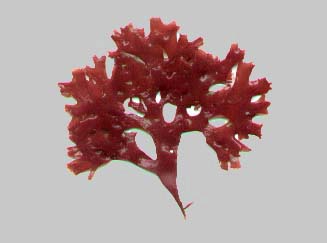
Irish Moss (normal colours)
Mud Dwellers
Ragworm
Hediste
diversicolor
Peppery
Furrow Shell Scrobicularia plana
Algae Homepage (Univ. of Galway)
Algae (Adur Estuary) List
Kingston Beach, by the Lighthouse, is near where the river enters the sea between the two piers of Shoreham Harbour.
 |
|
|
A SURVEY OF THE MARINE FLORA AND FAUNA
1960 TO 1992
- Local
Wildlife Links (SE England)
Adur
Nature Notes 2000
Adur
Nature Notes 2001
Adur
Nature Notes 2002
Adur
Valley
Adur
Valley Wildlife
Bridges
of the Adur
British
Trust for Ornithology
Chalk
Rivers Biodiversity (JNCC)
Cornwall
(Geomorphology, Eclipse etc.)
Dungeness,
Kent, England
Friends
of Lancing Ring
History
of the Adur Estuary by H. C. Brookfield (written 1950-1)
Orford
Ness: Coastal Ecology of a Shingle Bank (excellent references)
Ralph
Hollins Nature Pages (Chichester Harbour area)
Rare
Birds Photographic Index (by month) (All of Britain)
Rye
Harbour Nature Reserve
Rockpooling
Page
Seashore
Page
Shingle
Coast (Coastal Fringe of Shoreham Beach)
Shoreham-by-Sea
Wildlife Page
Sussex
Bat Group
Sussex
Ornithological Society
Sussex
Wildlife Trust
Sussex
Wildlife Web Sites
Trees
(British) External site
UK-LEPS
Discussion Group (for Butterflies and Moths)
Wildlife
& Conservation Links (West Sussex)
World
Oceans Day
|
|
|
|
|
|
